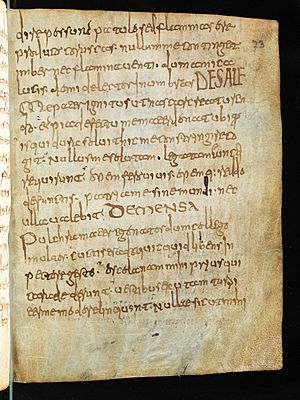Bern Riddles facts for kids
The Bern Riddles, also called Aenigmata Bernensia, are a group of 63 Latin riddles written in a poetic style. They are named after the city of Bern, Switzerland, where the oldest surviving book containing them is kept. This book, called Codex Bernensis 611, was made in the early 700s.
Where Did They Come From?
Most experts believe the Bern Riddles were written around the 600s AD. They were likely inspired by an older collection of riddles from the 300s, written by someone named Symphosius. We don't know who wrote the Bern Riddles. Some think the author might have been from a place called Lombardy in Italy, perhaps even from a monastery in Bobbio.
One expert, Archer Taylor, said that the author knew a lot about the plants and landscape of northern Italy. This makes him the "first medieval riddle-master in Italy." However, some scholars think the riddles might have come from Anglo-Saxon England, where other riddle collections were created around that time.
What Are the Riddles About?
The Bern Riddles cover a wide range of everyday things and nature. Here are some of the subjects they describe:
- 1. Bowl
- 2. Lamp
- 3. Salt
- 4. Bench
- 5. Table
- 6. (Glass) chalice
- 7. Air-bubble
- 8. Egg
- 9. Millstone
- 10. Ladder
- 11. Ship
- 12. Grain of corn
- 13. Grapevine
- 14. Olive
- 15. Palm-tree
- 16. Cedar-berry
- 17. Sieve
- 18. Broom
- 19. Wax tablet
- 20. Honey
- 21. Bee
- 22. Egg
- 23. Fire-spark
- 24. Parchment
- 25. Letters
- 26. Mustard
- 27. (Papyrus)-paper
- 28. Silkworm
- 29. Mirror
- 30. Fish
- 31. Siphon
- 32. Sponge
- 33. Violet
- 34. Rose
- 35. Lilies
- 36. Saffron
- 37. Pepper
- 38. Ice
- 39. Ivy
- 40. Mousetrap
- 41. Wind
- 42. Ice
- 43. Silkworms
- 44. Pearl
- 45. Earth
- 46. Pestle
- 47. Snail-shell
- 48. Chestnut
- 49. Rain
- 50. Wine
- 50a. [Wood-pulp] paper
- 51. Garlic
- 52. Rose
- 53. Weighing-scales
- 54. Weaving-loom
- 55. Sun
- 56. Sun
- 57. Sun
- 58. Moon
- 59. Moon
- 60. Sky
- 61. Shadow
- 62. Stars
- 63. Wine
Examples of Riddles
Here are a couple of examples of the Bern Riddles, first in their original Latin and then translated into English. Can you guess the answers before looking?
|
LI. De alio. |
51. Garlic. |
|
LII. De rosa. |
52. Rose. |
Old Manuscripts
The Bern Riddles have survived through history in several old handwritten books, called manuscripts. These books were copied by hand many centuries ago. Here are some of the most important ones:
| Name | Pages | Date | Number of Riddles | Notes |
|---|---|---|---|---|
| Cod. Bern 611 | 73-80v | Early 8th century | 33 | See manuscript here. Some parts of this book are missing. |
| Cod. Berlin Philipps 167 | 37v-45 | 9th century | 2 | |
| Cod. Leipzig Rep. I 74 | 15v-24 | 9th or 10th century | 63 | |
| Cod. Vienna 67 | 168v-170 | 12th century | 62 | |
| Cod. Vienna 2285 | 206-12 | 14th century | 62 | |
| Cod. Paris Lat. 5596 | 165- | 8th or 9th century | 9 | See manuscript here. |
| Cod. Paris Lat. 8071 | no foliation | Late 9th century | 2 | See manuscript here. Sometimes called Codex Thuaneus. |
| Cod. Vatican Reg. Lat. 1553 | 8v-21 (passim) | Early 9th century | 52 | See manuscript here. Mixed with riddles by Symphosius and Aldhelm. |
| Newberry Case MS f.11 | First half of 12th century | 62 | ||
| Cod. Vatican Barb. Lat. 1717 | 16th century | ? |


